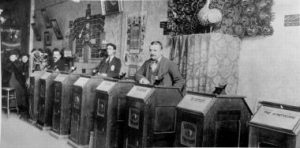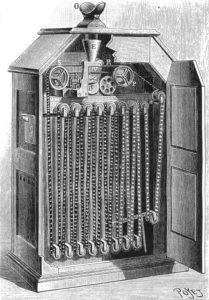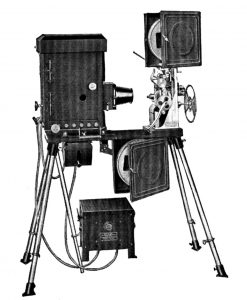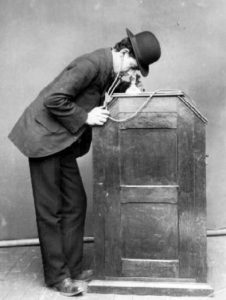The Kinetoscope is one of the earliest film exposure devices, designed to allow one individual at a time to view movies through a peephole at the top of the device.

Image source: https://en.wikipedia.org/wiki/Kinetoscope#/media/File:KinetoscopeParlorbis.jpg
The Kinetoscope introduced the basic approach that would later become the standard for all film projections before the advent of video, creating the illusion of motion by piping a perforated film strip with sequential images onto a source of light with a high-speed shutter.
What’s a Kinetoscope?
Kinetoscope, forerunner of the movie projector, invented by Thomas A. Edison and William Dickson of the United States in 1891. Inside, a strip of film was quickly passed between a lens and an electric light bulb as the viewer looked through a peephole, behind this was a spinning wheel with a narrow slot acting as a shutter, allowing a momentary view of the 46 frames that passed in front of the shutter every second. The result was a realistic representation of persons and objects in motion. At first, Edison considered his invention to be an insignificant toy.

Image source: https://en.wikipedia.org/wiki/Kinetoscope#/media/File:Kinetoscope.jpg
How it was created
Edison’s initial concept for his film device was based on the phonograph cylinder. Small photographic images following a sequence were attached to a cylinder, with the idea that an illusion of movement would be created through the reflected light as the cylinder rotated. However, tests showed it was ineffective.

Image source: https://en.wikipedia.org/wiki/Kinetoscope#/media/File:Optic_Projection_fig_221.jpg
Finally, when John Carbutt developed the emulsion-coated celluloid films, Edison began using them for testing during the development of the kinetoscope. Working under this new direction, Dickson, along with a new assistant, began creating a device with a horizontal-feed system for exposing film strips.
The final product
On August 24, 1891, Edison filed the patent for the camera (kinetograph) — peephole viewer (kinetoscope), indicating the film width of 35mm and the possibility of using a cylinder for future upgrades. The final product was completed in 1892, with a small modification: the horizontal-feed mechanism was replaced with a vertical one. It was officially presented to the public on May 9, 1893, at the Brooklyn Institute of Arts and Sciences. To watch a clip of moving images, the viewer peered into a peephole with magnifying glasses on top of the cabinet.

Image source: https://en.wikipedia.org/wiki/Kinetoscope#/media/File:Kinetophonebis1.jpg
The first videos ever created

Image source: https://en.wikipedia.org/wiki/Kinetoscope#/media/File:Ad_for_Thomas_Edison’s_Kinetophone,_1913.jpeg
In New York City at 1155 Broadway, on the corner of 27th Street, on April 14, 1894, the Holland Bros opened a public Kinetoscope salon, the first commercial film house. The venue had ten machines at its disposal, placed in parallel rows of five, each showing a different film. A viewer could see all the films in both lines for 25 cents. The new Kinetoscope Company had contacted Edison for the purchase and production of the machines. The ten films that make up the first commercial film program, all shot at the Black Maria, were descriptively titled: Barber Shop, Bertoldi (mouth support) (Ena Bertoldi, a British vaudeville contortionist), Bertoldi (table contortion), Blacksmiths, Roosters (a kind of cockfight), Highland Dance, Horse Shoeing, Sandow (Eugen Sandow, a German strongman), Trapeze, and Wrestling. Historian Charles Musser describes that a “profound transformation of American life and entertainment culture” had begun.
Info sources:
https://en.wikipedia.org/wiki/Kinetoscope
